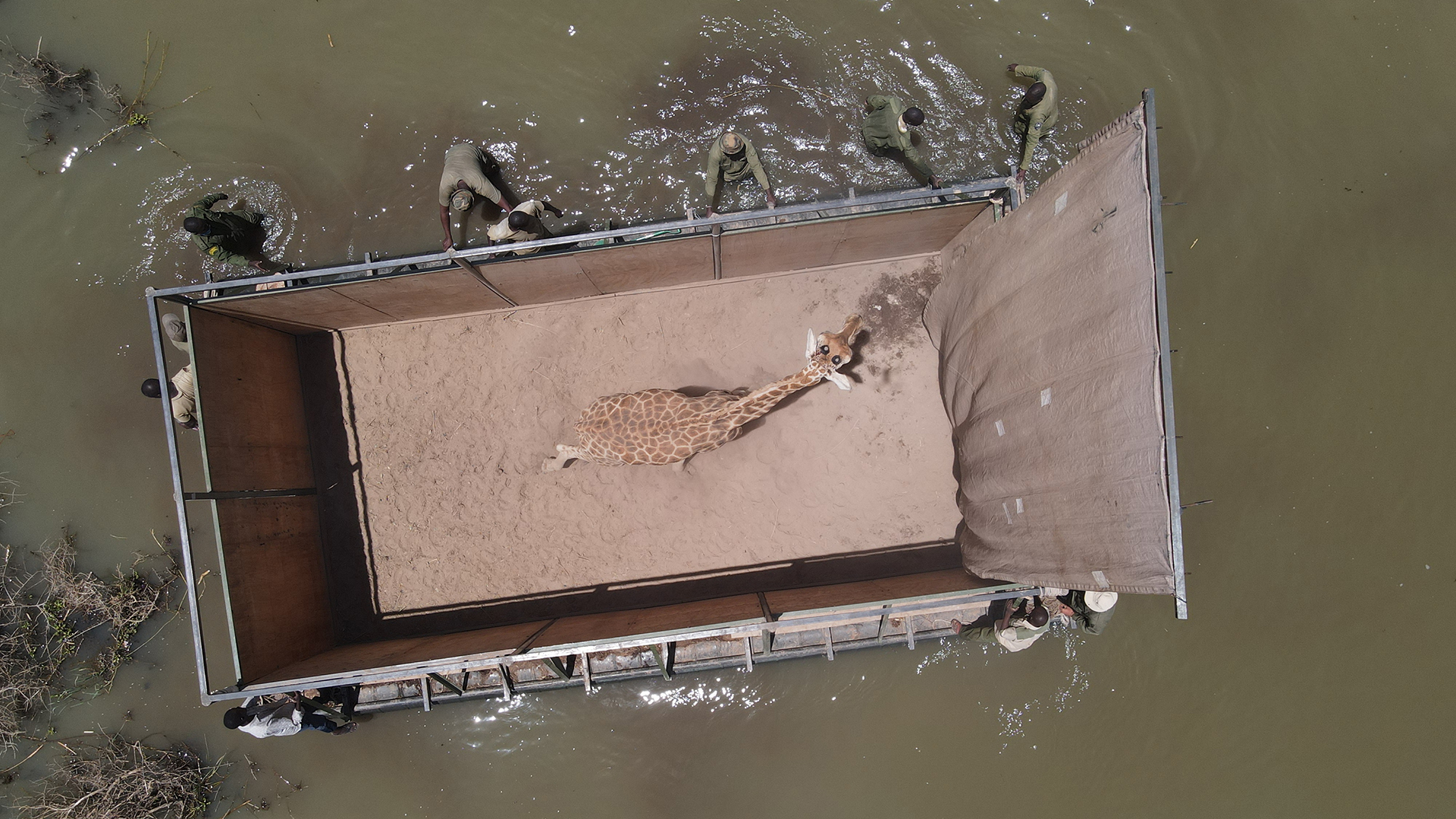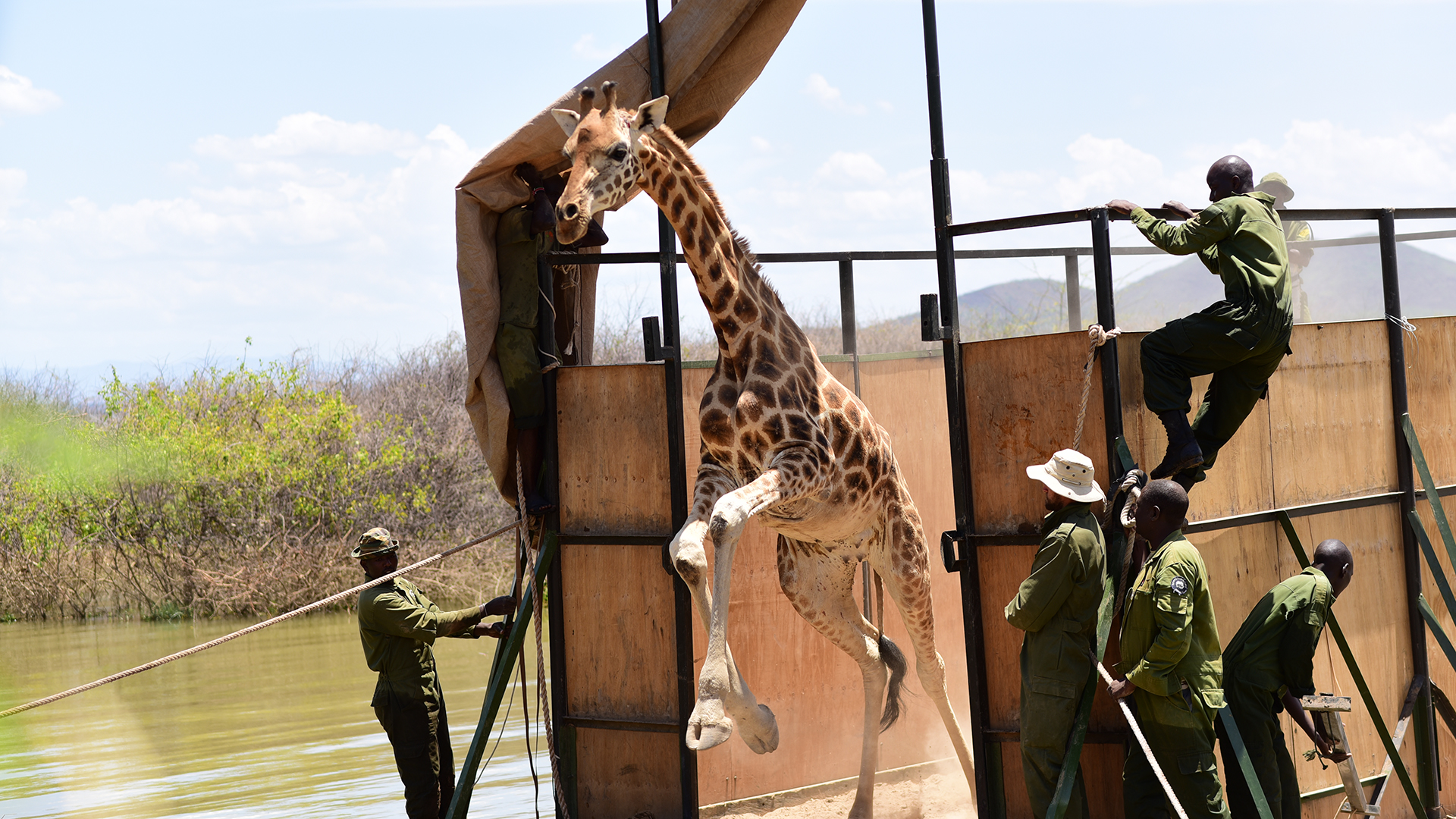Mom & baby giraffe trapped on a sinking island rescued in months-long operation
Ngarikoni and baby Noelle were the last of nine giraffes to be rescued.

How do you save a herd of giraffes that are trapped on a rapidly sinking island? Float them to the mainland on a custom-built barge — a "GiRaft."
That's how a months-long giraffe rescue operation in Kenya recently concluded on April 12, delivering the last of nine stranded giraffes to safety, according to a statement by Save Giraffes Now (SGN), an American nonprofit organization that partnered with conservationists in Kenya to relocate the giraffes.
The threatened giraffes, a highly endangered subspecies called Rothschild's giraffes (Giraffa camelopardalis rothschildi), had been living on Longicharo Island in Kenya's Lake Baringo since 2011. But rising waters repeatedly flooded their habitat, and conservationists, concerned that the giraffes could no longer find enough food on the island, decided to evacuate the animals.
Related: Rare white giraffe photographed
"Water levels in Lake Baringo have been rising for some time, but in 2020 the rate of rise increased," flooding coastal homes and businesses and threatening the survival of the giraffes, representatives of Kenya's Northern Rangelands Trust (NRT) posted on Facebook on Dec. 2, 2020, when the giraffe evacuation began.
To carry the gangly giraffes from their disappearing home to a new sanctuary on the mainland, SGN worked with NRT and other local conservation agencies: Ruko Community Conservancy and Kenya Wildlife Service. People from the Njemps and Pokot communities designed and built a giraffe-toting barge with tall, reinforced sides, buoyed by 60 empty drums and towed by boats.

Rangers helped the giraffes get used to the GiRaft over time by parking it on land and encouraging the animals to investigate it by loading the barge with delicious treats, such as mangos, seed pods, food pellets and acacia leaves, according to the SGN. Once the giraffes were familiar with the GiRaft, rescuers transported them one at a time to higher ground in an enclosed sanctuary at the 44,000-acre (178square-kilometer) Ruko Conservancy, located about 1 mile (1.6 kilometers) across the lake from the island.
Sign up for the Live Science daily newsletter now
Get the world’s most fascinating discoveries delivered straight to your inbox.
The first passenger to board the GiRaft was a female giraffe named Asiwa, as rising waters had already separated her from the rest of the herd, NRT representatives wrote on Facebook. Over the following months, more giraffes were taken across the lake, and on April 12, the last remaining giraffes — a female named Ngarikoni and her baby Noelle, born at the end of December — completed the journey, according to the statement.

Giraffe populations in general have declined by about 40% over the past three decades, but Rothschild's giraffe numbers have dwindled by approximately 80%, making it "arguably one of the most imperiled giraffe subspecies," according to a study published in 2019 in the African Journal of Ecology. Rothschild's giraffes were once widespread across Kenya, Uganda and southern Sudan. Now only around 3,000 remain in isolated populations in Uganda and Kenya, lending a greater urgency to the GiRaft rescue mission, SGN president David O'Connor said in the statement.
"With giraffes undergoing a silent extinction, every one we can protect matters, making this rescue an important step in supporting the survival of this species," O'Connor said.
The happy ending to the island giraffes' story also reflects a landmark collaboration between the Njemps and Pokot communities, which have united in conservation efforts after years of conflict.
"Ruko is an example of how much peace is linked to everything else — conservation, livelihoods, business, gender equality, governance," Rebby Sebei, manager of Ruko Community Conservancy, said in the statement. "It all starts with peace."
Originally published on Live Science.

Mindy Weisberger is an editor at Scholastic and a former Live Science channel editor and senior writer. She has reported on general science, covering climate change, paleontology, biology and space. Mindy studied film at Columbia University; prior to Live Science she produced, wrote and directed media for the American Museum of Natural History in New York City. Her videos about dinosaurs, astrophysics, biodiversity and evolution appear in museums and science centers worldwide, earning awards such as the CINE Golden Eagle and the Communicator Award of Excellence. Her writing has also appeared in Scientific American, The Washington Post and How It Works Magazine. Her book "Rise of the Zombie Bugs: The Surprising Science of Parasitic Mind Control" will be published in spring 2025 by Johns Hopkins University Press.









